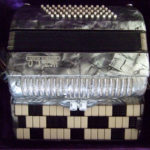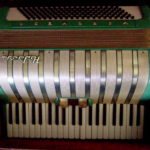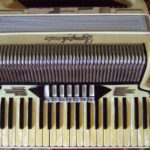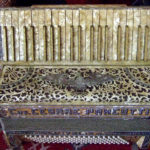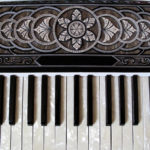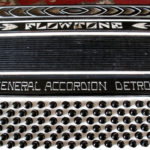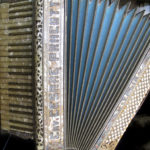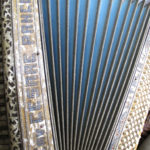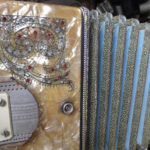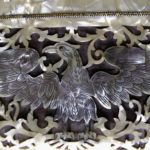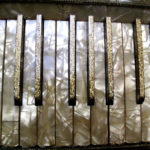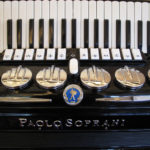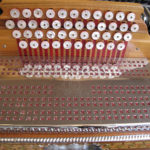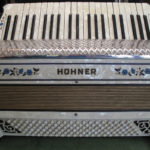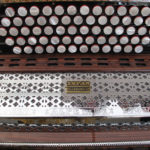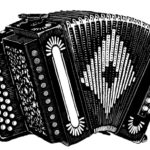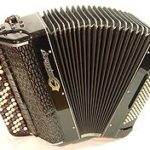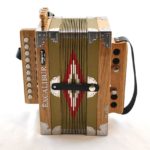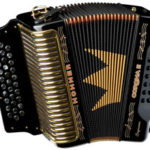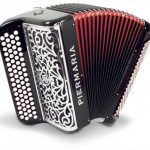Accordion 101: Types of the Accordion



Accordions come in many sizes and shapes. Some have buttons, some have (piano) keys. And depending on the year they were made and who made them, the reeds might be different, the number of keys might be different, and even what they’re made of can be different. The design and sounds vary from one instrument to another as a result; some vintage instruments exhibit exquisite decorations, while more contemporary instruments show technological advancements. You can get a glimpse of the wide variety of the instruments and their beauty in the photo gallery at the bottom of this page.
1. Piano and Button Accordions
Broadly speaking, there are two main types of accordion–the “button” accordion, and the “piano” accordion. If the right hand, or treble side, is made up of buttons, then the accordion is a button accordion. If the right hand, or treble, side of the accordion is made up of black and white piano keys, then it’s a piano accordion. You can read more about how the piano accordion came to be below in the “development of the piano accordion” section. (Left, button accordion; right, piano accordion)


2. Unisonoric and Bisonoric Accordions
Another broad differentiation can be made between “unisonoric” and “bisonoric” accordions. These terms refer to how the action of the bellows produces notes, or pitches, by moving air through the reeds. A key or button on a unisonoric accordions produce the same pitch regardless of the direction of the bellow action. When depressing one button on a bisonoric accordions, however, two different notes can be played–one note when the bellows is pulled out, and another, different note when the bellows is pushed in.
3. Diatonic and Chromatic Accordions
Lastly, there is a distinction between diatonic and chromatic accordions.
Diatonic Button Accordion. Most diatonic accordions are button accordions, and have two or three rows of buttons. Each row is tuned to a specific key, having only the notes of that scale. They are also almost always bisonoric; each button produces different pitches depending on the direction of the bellow action. Because diatonic button accordions are generally only in one (or two) key(s), players need several instruments to play in different keys.

 Musical genres that use the diatonic button accordion include many kinds of musical styles around the world — Cajun and Norteño musicians use this style of instrument almost exclusively. (Photos: left is a cajun diatonic button accordion, and right is a diatonic button accordion popular among Norteño players.)
Musical genres that use the diatonic button accordion include many kinds of musical styles around the world — Cajun and Norteño musicians use this style of instrument almost exclusively. (Photos: left is a cajun diatonic button accordion, and right is a diatonic button accordion popular among Norteño players.)
Chromatic Button Accordion. Button accordion can also be chromatic. Chromatic button accordions are unisonoric; the same button sounds only one pitch, whether you are pulling or pushing the bellows. The right hand side often has three to five rows of buttons, and these accordions are not limited to any specific key — one chromatic accordion can play in any keys. Chromatic button accordions are popular in the French musette music (photo below, right), and the Russian bayan music (photo below, left).


Piano Accordion (Chromatic.) Piano accordions are always chromatic and unisonoric, and the piano accordion is widely used in Italian music, Balkan region, and some German music.
In our Squeezebox Stories, Vince Cirelli, Skyler Fell (“Master Craftsman and Young Apperentice), and Elias Lammam (“Arabic Accordion Master”) play the piano accordion, and Carlos Mendoza and Los Yukinos play the diatonic button accordion (“Oaxacan Pride in the New Land”). Andre Thierry (“Zydeco, Home Away from Home”) plays both the piano accordion and diatonic cajun button accordion, which is quite common among zydeco players.
Development of the Piano Accordion
Although the first accordions were diatonic button accordions, chromatic “piano” accordions were soon developed around the turn of the 20th century. There is some dispute about where and when this development took place, but one record holds that the first piano keyboard was introduced by Bouton in Paris in 1852. Others emphasize the importance of the Diero Brothers — Vaudeville musicians in San Francisco — in popularizing the piano accordion in the United States. Although the button accordion was more prevalent until this time, the Diero brothers’ illustrious career as piano accordion performers, recording artists, composers, and teachers, solidified the piano accordion’s popularity in the U.S. (For more on the Diero Brothers, you can go visit History 1: Italian Immigration.)
Part of the reason for the appeal of the piano accordion appears to have been from the manufacturer’s marketing strategy; the idea was to make the instrument more familiar to people who already knew how to play the piano. The extremely successful and nationally popular TV program “Lawrence Welk Show”(1955-1982), hosted by the band leader and accordion player Lawrence Welk, helped pave the way for the acceptance of the piano accordion as well. (For more information on Lawrence Welk, you can listen to Story One.) By the mid 20th century, the piano accordion had become the most popular type of accordion in the United States as a result — piano accordion was an affordable musical instrument for the growing middle class.
Below, you can enjoy the wide variety of the accordion from various parts of the world and times in the history. (Special thanks to Gee Rabe and Martin Hergt for sharing their collections with us.)
